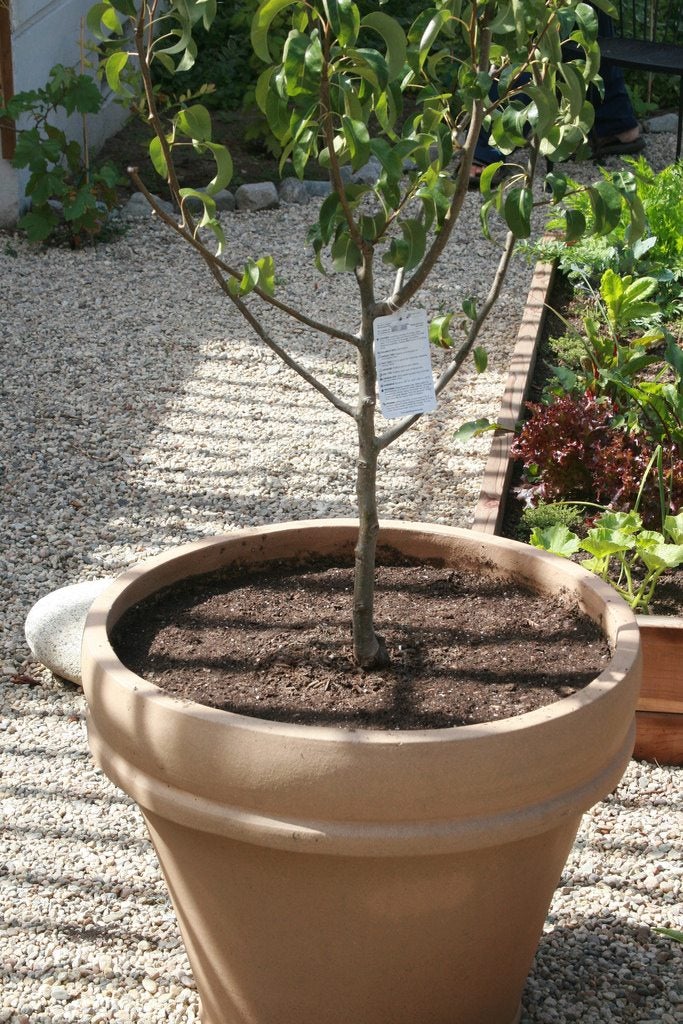Can Peach Trees Grow In Pots: Tips On Growing Peaches In A Container

People grow fruit trees in containers for a number of reasons - lack of garden space, ease of mobility or insufficient light in the garden proper. Some fruit trees do better than others when grown in containers. How about peaches? Can peach trees grow in pots? Read on to find out how to grow peach trees in containers and about container peach tree care.
Can Peach Trees Grow in Pots?
Absolutely; in fact, growing peaches in a container is an ideal growing method. Peaches bloom as early as March, so growing peaches in a container makes the it easier to protect the tree from sudden frost or winds.
There are a few things to consider if you want a container grown peach tree. First, unlike apple trees, peaches have no dwarf rootstock to keep the trees small. Instead, some varieties naturally grow smaller. These are called “natural dwarfs” and, while they produce full size fruit, the trees remain smaller, up to 6 feet (2 m.) in height or even smaller for container grown peach trees.
You can procure a bare root tree from the internet or a nursery catalog that will be shipped to you when it is the correct time to plant the tree in your region. Or you can purchase a bare root peach from the local nursery. These should be available towards the end of winter into the early spring, and can be planted at most any time with the exception of the height of summer.
How to Grow Peach Trees in Containers
There are several varieties of natural dwarf trees to choose from when growing peaches in a container.
- Golden Glory is a natural dwarf variety that only gets to around 5 feet (1.5 m.) in height.
- El Dorado produces richly flavored fruit with yellow flesh early in the season.
- Honey Babe needs a cross pollinator that is also a dwarf.
There are also small nectarines trees, which are really peaches without the fuzz, that will do well container grown. Nectar Babe and Necta Zee are both good container grown nectarine options.
You will also need to consider your chill hours before selecting a tree. Peaches generally need 500 chill hours, so anyone living in the warmer south will need to purchase a “low chill” variety. Those in regions with temps below 20 F. (-6 C.) can grow any variety but will need to protect it.
Sign up for the Gardening Know How newsletter today and receive a free copy of our e-book "How to Grow Delicious Tomatoes".
Choose a spot in full sun, 6 hours or more of direct sunlight, to situate your container. For dwarf trees, use a container that is at least 5 gallons (19 L.) and has drainage holes. Place the container on a tray filled with a few inches of gravel or pebbles to allow for better drainage. Fill the pot half up with a loamy compost soil. Put the new tree into the pot and fill in and around the plant up to a couple of inches (5 cm.) from the top of the container. Make sure the graft line is not under the soil.
Container Peach Tree Care
Water the newly planted tree deeply until water flows from the drainage holes. If the tree is bare root there is no need to water again for another couple of weeks unless there is an extended heat wave. Otherwise, water the tree deeply whenever the soil dries out, about every 5-7 days in the spring and up to every other day in the summer.
Keep a close eye on the watering since container grown trees tend to dry out more quickly than those planted in the garden. Cut back the amount of water in late August or early September. This will slow the trees growth in preparation for winter.
Not only do container grown trees need more water than those in the garden, but they also require more fertilization. Apply a liquid fertilizer every couple of weeks. Choose a fertilizer that is made to facilitate flower and fruit production; that is one that is high in phosphorus. Taper off on fertilizing around the same time that you lessen the amount of water the tree gets.
Pruning is another factor. Suffice it to say that the tree should be pruned into a vase shape to facilitate harvest and production. If you want the tree to grow larger peaches, pinch off every other small peach. This will allow the tree to put more energy into growing the remaining fruit larger.
In colder climates, move the tree indoors and place it near a sunny window or in a greenhouse. Bring the tree back outside around April when exterior temperatures have warmed and all chance of frost has passed.

Amy Grant has been gardening for 30 years and writing for 15. A professional chef and caterer, Amy's area of expertise is culinary gardening.
